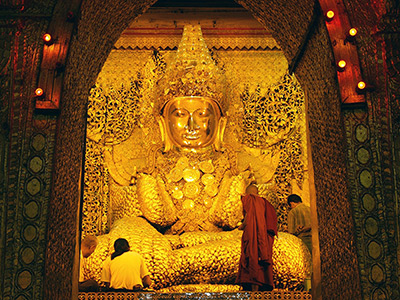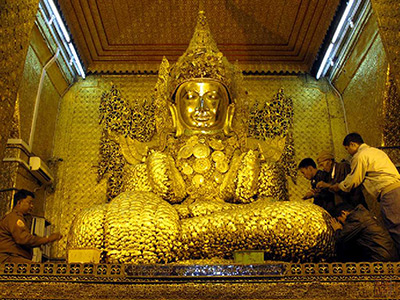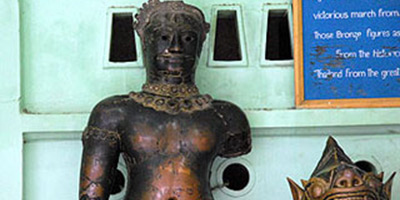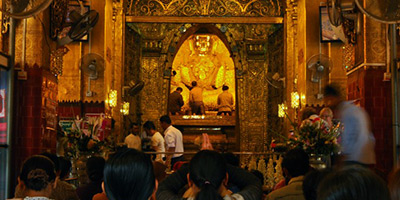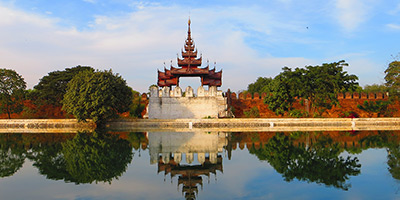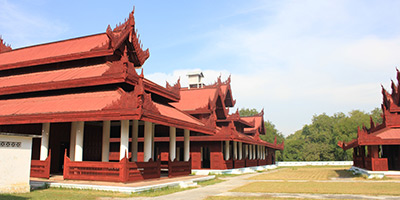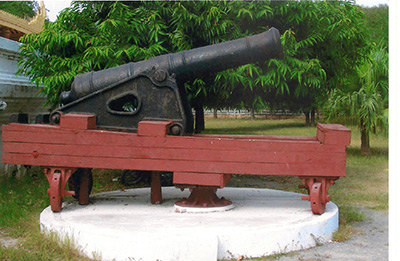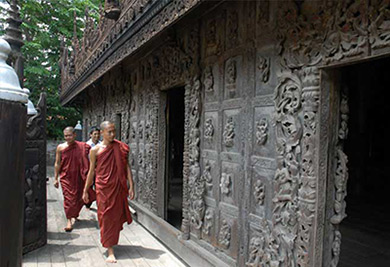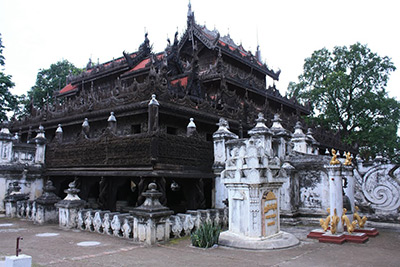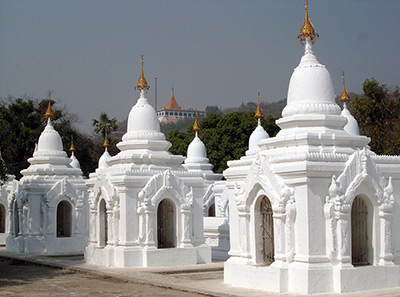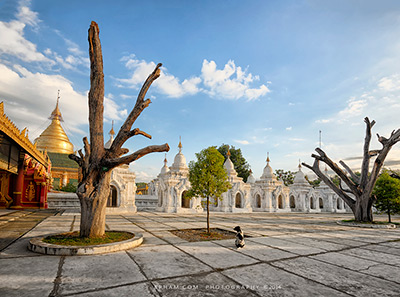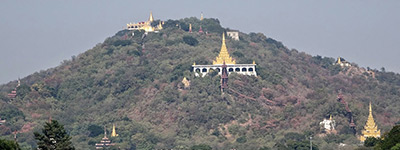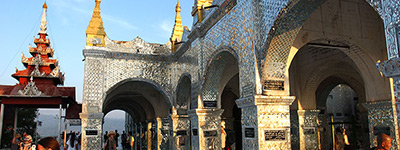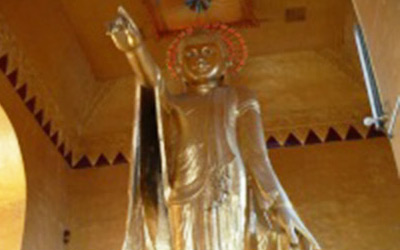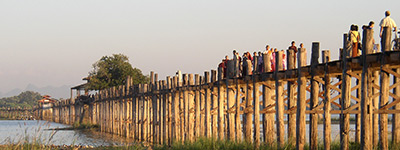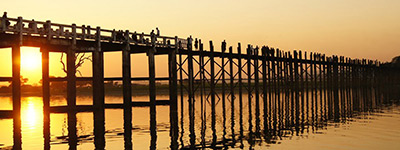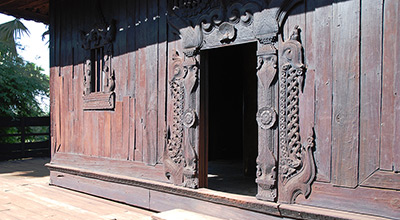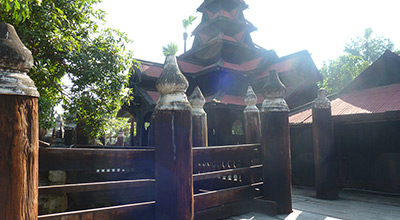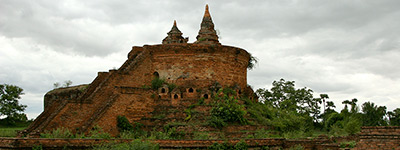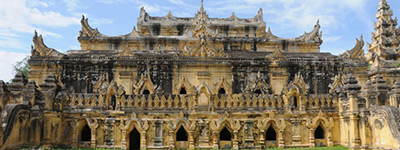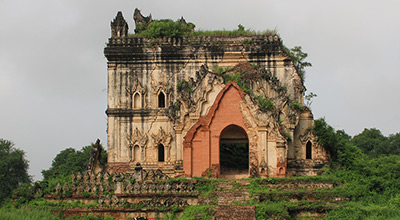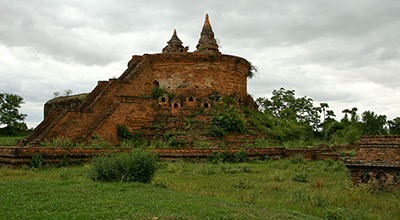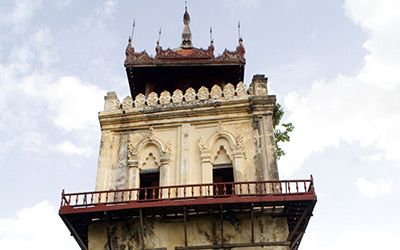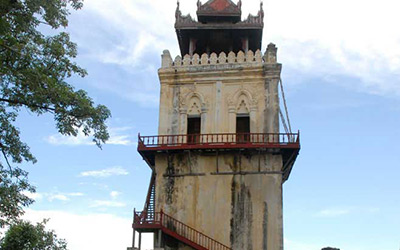Mandalay
ndalay the last capital of the Myanmar Kings is located in the Central Myanmar, 668 km north of Yangon. Today it’s the second largest city with rich cultural heritage. It’s also the commercial center with rail, road, river and air links to all parts of the country. Mandalay is best known not only for its rich traditional, cultural and spiritual splendor but also exquisite handicraft such as hand-woven embroidery in silk and cotton, the incredible process of making gold leaves. Wood and stone carving and bronze casting etc. There are several ancient capitals around Mandalay such as Amapura, Sagaing, Ava, Mingun where Kongbiung dynasty kings established their capitals respectively. To recovered the main highlight site it’s need 1 or 2 night stop .
Mahamyatmuni Pagoda
The Maha Myat Muni Pagoda is located at the Southwest of Mandalay, where inside lies the Maha Myat Muni Buddha Image. The Maha Myat Muni Buddha Image is the most revered Buddha image in Mandalay. It is also known as the Phaya Gyi. It is the most ancient Buddha image in Myanmar. It was cast in the life-span of Lord Buddha in the seated posture of relaxed deportment, namely Bumi Phasa Mudras, symbolic of His Conquest of Mara. The 4m high-seated image is cast in bronze and weigh 6.5 tons, which it's crown is decorated with diamonds, rubies, and sapphires. Maha Myat Muni Buddha Image was being cast in front of the Buddha himself it can say Maha Myat Muni Buddha Image is the portrait of Buddha and the face is most revered. Every morning at 4:30AM, a team of monks washes the face and brushes the teeth. Since Myanmar Buddhists are so devout countless thousands of devotees apply gold leaf to gain merit, the image has completely covered with 15 cm thick gold and original shape is distorted.
History
In B.C 123, in the reign of King Sanda Thuriya, Monarch of Rakhine-Dharyawaddy, and carry the Image reverently so as to enshrine it at the present site. It took four months to carry the image reverently across the Rakhine Yoma Ranges, by inland route and by waterway a tough and rough journey indeed. The Height of the Maha Muni Buddha Image is 8 Cubits and 1 Maik ( 3.83m ). The altar is 2.13m high. There, 2 bronze Siamese images, 3 bronze lion images and 1 bronze three headed Ayeyawun elephants are housed and displayed in the precinct on the left side of the northern exit passage.Whoever visits Mandalay from local areas or from abroad unfailingly come and pay homage to the Maha Muni Buddha Image.King Bodawpaya built this Pagoda in 1784 to house the Maha Myat Muni Buddha Image brought from Rakhine State. Being the most revered Pagoda in Mandalay, the early morning ritual of washing the face of the Buddha's image, draws a daily crowd of devotees.
Travel Tips
To be able to catch up the early morning ritual, one has to be at the pagoda by about 5 am.
Mandalay Palace
The Royal Mandalay Palace is located between 12th street and 26th street, in the heart of Mandalay city. Mandalay Palace was the first palace to be built in Mandalay, by King Mindon when he shifted his capital from Amarapura in 1861, to fulfill an old prophecy.The site was chosen with the auspicious omen and astronomical calculations.
Structure of the Palace
The magnificent palace was built of teak wood on raised brick plinth gilded with gold and vermilion. The queens' chambers in order of priority is 1 Southern, 2 Northern and 3 Lesser queens in the West. All ancillary buildings for the court, the fortified high walls with ramparts, the moat, water systems, roads, gardens with shady tamarind trees, recreational playgrounds, swimming pools, mint, security ports with infantry, cavalry, archers, artillery, sheds for royal elephants, stables, audience halls, throne halls, religious edifices and monastery and devotional halls were superbly planned and executed to minute details. The implementation and completion of construction took five years (from 1857 to 61). The artistic workmanship and handicrafts depicting the glory of the golden age of the days gone by is still amazing, awe inspiring and the beholder will be spell bound with wonder.The entity of the palace cannot be separated from the Mandalay Hill, from where the prophecy and name is dewed. Located right in the center of the palace grounds, which is meticulously a true square, enclosed within fortified high walls with ramparts and the beautiful deep moat all the layout in perfect squares. So much so the city surrounding the place too had been laid-out in blocks of squares enclosed by sheets.A muddy canal feeds the supply of water to the moat. It is surprisingly strange that the red muddy water turns crystal clear. This moat water is potable and the source of home consumption and is free from lime content. It also serves a double purpose as a good protection from enemy assault of those days.
Surroundings
The reflection of the Mandalay on the eastern moat is a beautiful scene to behold from the southeastern corner. The panoramic view of the Palace and the surrounding areas as far as the Sagaing Bridge, the Ayeyarwady River and the hill ranges seen from the Mandalay Hill during sunset will be an enchanting experience.The beautiful palace with many other buildings were destroyed by fire due to the ravages of been reconstructed in brick masonry from photographic records, plans and drawings.
Travel Tips
Some of the dresses of the ancient kings, queens, princes, princesses and other ministers are displayed. You can also wear them and take some pictures. Entrance Fee : US$ 5.
Golden Palace Monastery
Shwenandaw Monastey is located near the 14th Street, Mandalay. It is also close to Atumashi monastery. The Shwenandaw monastery is the most significant of Mandalay’s historic buildings, since this ‘Golden Palace Monastery’ remains the sole major survivor of the former wooden Royal Palace built by King Mindon in the mid-nineteenth century.The Shwenandaw is a wonderfully fragile yet grand example of 19th century Myanmar teak architecture and also a significant masterpiece of the wood-carver’s art.
Travel Tips
Entrance Fee : US$5 per person
Kuthodaw Pagoda (Big Book)
Located at the foot of Mandaly Hill, the Kuthodaw Paya (Mahalawka Marazein Kuthodaw Pagoda) complex is one of the most interesting places in the city. The Paya was built during the reign of the Mindon Kingdom. The main Pagoda was modelled after the Shwezagon Paya at Nyaung-U (near Bagan). The paya is surrounded by 729 pavillions containing marble-slabs with pages of the 15 books of the Tripadaya (the Canon of Theravada Buddhism), so every slab contains one page of the Canon. The Mindon Min king convened the 5th Buddhist synod in 1871 using 2,400 monks to read the whole book, and decided to have set in stone the Tripadaya for posterity. The complex were looted during British annexation, and was restored around 1900.
Mandalay Hill
Just outside the North of downtown, Mandalay Hill which summit is 230 m above the surrounding plain is the natural watch-tower for the visitors to watch sunrise or sunset over the city plains. Every one who arrived in Mandalay, the ancient capital of Myanmar, usually goes to Mandalay Hill, the landmark of Mandalay, which overlooks the city. At the bottom in front of the southwest entrance are the two immense statue of Lions guard the holy hill.If you drive by car from the archway of Mandalay hill, you will reach the entrance of escalator of the hill. From there, you can proceed to the top of the Mandalay hill by escalator and pay homage to Su Taung Pyi Pagoda,means wish-granting Pagoda, built by King Anawratha in 414 Myanmar Era.It was patronized and renovated by successive KonBaung Kings. You can study documentary photos of Mandalay hill on the platform of Pagoda.Moreover, the stairways are being constructed from the bottom to top of the hill which you can climb at ease and rest as you go up the stairway. There is a saying that if you want to live long, you take refuge in the environs of Mandalay hill. It means that as climbing to the Mandalay hill on foot is good for health.And to pay homage to the pagoda along the way makes one live long. You can pay homage to prominent pagodas along the stairway of Mandalay Hill. Besides, you can visit the shops of Myanmar traditional handmade toys, gifts such as beads. If you reach the top of the hill, you can pay homage to Su Taung Pyi Pagoda. Moreover, you can view the elegant craftsmanship with two Snakes raising the hoods up.
Sutaungpyi Pagoda
The pagoda and its ancillary pavilion are located near the top of Mandalay Hill, the holy hill from which the Buddha reportedly predicted that a great religious city would emerge at its base. It is suggested that the pagoda was originally built by the great builder of Bagan, King Anawratha, in 1052. This "wish-granting" pagoda was often renovated by its patrons, the Konbaung kings, in later years. Perhaps the most famous of the renovators of the religious structures on Mandalay Hill was U Khan Dee. the famous and legendary "Hermit on the Hill", who spent 41 years of his life on the hill raising funds for many structures, including Sutaungpyai, where he spent many years.
History
During the time when Buddha was alive while on one of his visits to Myanmar, the Buddha with his disciple Ananda climbed Mandalay Hill and prophesied that a great city would be founded below the hill and also pointed the place of that future city.Then a huge standing Buddha image was built at the place where Buddha stood, with his hand pointing to the Royal Palace. The legend has it that the Buddha, on his visit, had made a prophecy that a great city would be founded at the foot of this hill.
Environment
The dominant natural feature of Mandalay is its 790 ft (240 m) Mandalay Hill, which towers above the city and the flat plain below.Virtually all visitors and pilgrims to Mandalay either climb the 1,729 steps of the covered southern stairway with its magnificent guardian chinthe (half-lion, half-dragon) at the entry, use stairways on the other sides or use easier means and take the escalator, cars or buses to the top.From its top, and from several way stations along the ascent, one has a magnificent panorama of the city, the old Royal Palace and Fortress, as well as the Ayeyarwady river and the distant Shan Hills.As Mandalay hill looks like a natural tower, you can enjoy the panoramic views of Mandalay and its environs from there. Sagaing Hill, Ayeyarwady River and Mingun in the west and Yankin hill, YaeTa Khun Hill in the east can be enjoyed with pleasure.In the evening, the platform of Mandalay Hill’s Su Taung Pyi Pagoda is crowded with tourists and devotees who record the beauty of sunset.If you visit Mandalay, the ancient capital of Myanmar, we invite you to enjoy the natural beauty of Mandalay hill not very far from the capital and to pay homage the prominent pagodas there.
Travel Tips
Entrance Fee : US$5 per person
Amarapura
11 km south of Mandalay is the town of Amarapura (City of Immortality). It was the capital of Konbang Dynasty at 18th century. It lies on the left bank of the Irrawaddy River. This town is famous of silk and cotton weaving even it’s also known as the weaving town. Place of interest are Pahtodawgyi Pagoda, U bein bridge (1.2km) longest wooden bridge in Myanmar, Mahagandayone Monastery and Kyauktawgyi Pagoda.
Mahagandaryone Monastery
The Mahagandayon Monastery, which located in Amarapura, is one of the largest teaching monasteries in Myanmar. It is usually one of the destinations of tour itineraries to Mandalay. If you are travelling independently, just ask your driver to take you to the monastery. In the Buddhist Lent Festival, thousands of monks converge on this monastery, contributing to the religious atmosphere of Amarapura.As one of the largest teaching monasteries in Myanmar, Mahagandayon Monastery, just west from U Bein’s Bridge (Bridge of Love) in Amarapura, is home to several thousand young monks. The Monastery was founded in 1914, regarded as a center for monastic study and strict religious discipline. Mahagandayon Monastery is usually one of the major destinations of Mandalay tour. If you visit at 11am, you can watch the whole monastery eating silently. In the Buddhist Lent Festival, thousands of monks gather in Mahagandayon Monastery, contributing to the religious atmosphere of Amarapura.
U Bein Bridge
U Bein Bridge is situated in the ancient city of Amarapura, Mandalay Region, which is about 1.2km in length of wooden bridge. It is the longest teak bridge in the world and is about two centuries old. This bridge became to be known as U Bein Bridge after the name of the donor, U Bein who was a clerk to the Mayor of Amarapura.
Bagaya Monastery
Bargaya Monastery was built in 1834 A.D. during the reign of King Bagyidaw. Being built entirely of teak wood, the monastery has 267 gigantic teak wood posts. The biggest post measuring 60 feet high and 9 feet in circumference. The monastery is a structure of great dimension for it is 188 feet in lenght and 103 feet in breadth. The monastery is a storehouse of Myanmar curtural heritage, representing ancient architecture and sculpture in several artistic objects which are rarely found in the monastery of a later date.
AVA (Innwa)
Mahaaungmyaybonzan Monastery
The Maha Aung Mye Bonzan. well known as Me Nu Oak-kyaung (Brick Monastery). was built in 1822 by Nanmadaw Me Nu. Chief Queen of King Bagyidaw. for the royal abbot Nyaunggan Sayardaw U Po. then offered to the 2nd Nyaunggan Sayardaw U Bok. I was also damaged by the earthquake of 1838 but was repaired in 1873 by Sinphyumashin. the daughter of Me Nu and a queen of King Mindon. This monastery is one of the finest specimens of Myanmar architecture during the Konbaung Period (19th century). Its architecture is in simulation of wooden monasteries with multiple roofs and a prayer hall of seven-tiered superstructure.The name Bargaya is a Mon word. It literally means Khayebin Kyaung. The Bagaya monastery was built on the southwest of Inwa palace on 1593. During Hsin Phyu Shin's reign (1763-1776. Atwinwun Mahathirijeyathankhya. town officer of Magwe built the monastery in the Bagaya monastic establishment and dedicated to Shin Dhammabhinanda. During King Bagyidaw (1819-1837) the great fire broke out to Kontha quarter. to the south of the palace on 15 April 1821 and Hluttaw. tooth relic tower. watch tower and to northern gate caught fire and seemed that the Bagaya monastery was burnt in the fire.The government tried to reconstruct in 1992. It intends to build a ( gadhakuti) special shrine for the use of Buddha image and Pitaka scriptures. So it put the new Brick building in the place of the old monastery. It was recorded that the monastery was constructed on the model of the old monastery.The grand Bagaya monastery. decorated with splendid Myanma architectural works. is in the ancient city of Innwa.King Bagyidaw of Innwa era built the Bagaya monastery at the confluence of the Ayeyawady and the Myitnge rivers in 1196 Myanma Era.
Ava palace
Inwa was formerly known as Ava and it is located 21km from Mandalay. Inwa was also known as Yadana Pura. It was first founded as a capital by King Thado Minbya in 1364 A.D. It is the confluence of the Ayeyarwaddy & Myint Nge rivers. But the king had a canal dug to join the Myint Nge and Myint Tha rivers thus cutting off the capital as an island. safe from enemy attacks. As successive kings ruled the war with King Raza Darit of Bago for many years. the Shan chief Thohan Bwa took the advantage and overran the capital. Gradually the kingdom grew weaker and finally it became a vassal to the Taungoo Empire. Later kings shifted the capital from Inwa back and forth many times until King Bayint Naung's son King Nyaung Yan re-established his capital at Inwa in 1596 A.D. It continued to be capital till 1782 when Bodawpaya moved the capital to Amarapura. But his son King Bagyidaw moved his capital back to Inwa. It was destroyed by the earthquake of 1838. The ruins of the palace. the massive fort walls and moat can still be seen of the splendour of the past when it had been the capital for more than four and half centuries. Inwa lies south of Mandalay and can from there in only 30 minutes of drive be attained. This old king city was long time capital of Oberburma. The foreign country was at present well-known Myanmar as the Kingdom of Ava.The king palace at that time does not exist any longer. however still the Nanmyint awake tower. From 27 meters height of bird perspective one can examine the range of the historical place. Numerous pagodas. temple and monasteries outlasted however Inwas' eventful past. The monastery Maha Aung Myay Bon Zan built with brick and stucco is particularly interesting. It was established to 1818 by the queen Me Nu for the royal abbot at that time U Po.There is a reverential statue on a throne in the Marabin or a large hall with its partition reaching from the floor to the ceiling of the monastery. The statue was sculptured with the handiwork of Innwa Era. The grand Bagaya monastery is still existing today in its original form. All the Myanmar nationals can be proud of the splendid monastery which is like an ancient arts museum.
Watch Tower (Nan Myint)
The watch tower which is about 90 feet (30 m) high is a solitary masonry building that remains of Bagyidaw's palace built in 1822. Owing to the earthquake of 1838. Only the lower part was left but it was restored as its original structure. The watch tower is one of the examples of Myanmar architectural style of early 19th century.


